If you consider the Jersey Devil as a product of early American alchemy, it transforms into a symbol of societal anxieties and failed transformations. The legend stems from the Leeds family's tumultuous history, intertwining chaos and power struggles. Alchemy's focus on change echoes in the creature's narrative, representing the fears of the unknown in colonial America. You'll find that the blend of folklore and political tensions shaped the myth, illustrating how cultural narratives evolve. This creature is more than just a story; it embodies the complexities of human nature and societal fears. There's much more to uncover about this fascinating legend.
Key Takeaways
- The Jersey Devil's origins could symbolize failed transformations in alchemy, reflecting societal fears and the struggle for control over nature.
- Alchemical practices emphasized transformation, suggesting the creature represents the darker aspects of human nature and societal anxieties about the "other."
- The Leeds family's history, intertwined with alchemical themes, illustrates the chaos and rebellion against societal norms prevalent in early America.
- Folklore, including the Jersey Devil legend, mirrors cultural tensions, using alchemical symbolism to depict transformation and the unknown in a colonial context.
- The creature's narrative could be viewed as a cautionary tale rooted in alchemical beliefs, warning against the dangers of misunderstanding and fear of nonconformity.
Origins of the Jersey Devil
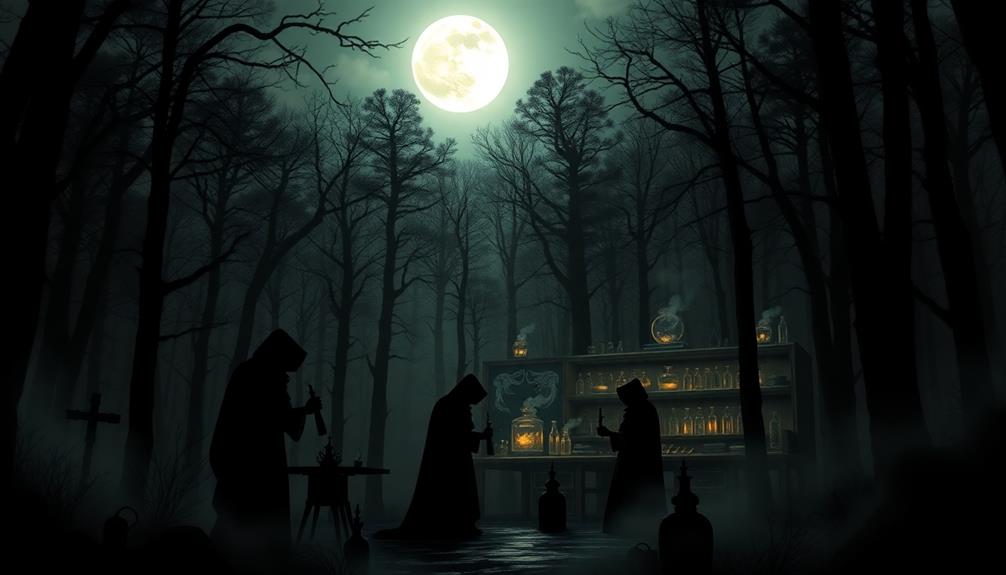
The legend of the Jersey Devil takes root in the early 1700s, emerging from the dense Pine Barrens of New Jersey. You might hear whispers of Mother Leeds, a woman who supposedly gave birth to a malformed creature that flew up the chimney. This unsettling tale began to circulate around 1735, influenced by local Native American legends and the controversial ideas of Daniel Leeds, a member of the Leeds family. His scientific pursuits sparked tension in the community, adding fuel to the fire of this eerie narrative.
As the story evolved, the Leeds family's crest, featuring a winged dragon, contributed to the growing monster mythos. During the Colonial period, sentiments against the British heightened, and the Jersey Devil became a symbol of rebellion and fear.
By the late 1700s, this narrative shifted from a family-specific tale to a broader ghost and monster story, mirroring the societal anxieties of the time. The Pine Barrens, often viewed as an isolated and mysterious land, served as the perfect backdrop for this chilling legend.
The Jersey Devil's notoriety surged in the early 1900s, showcasing its transformation in American folklore.
Alchemy in Early America
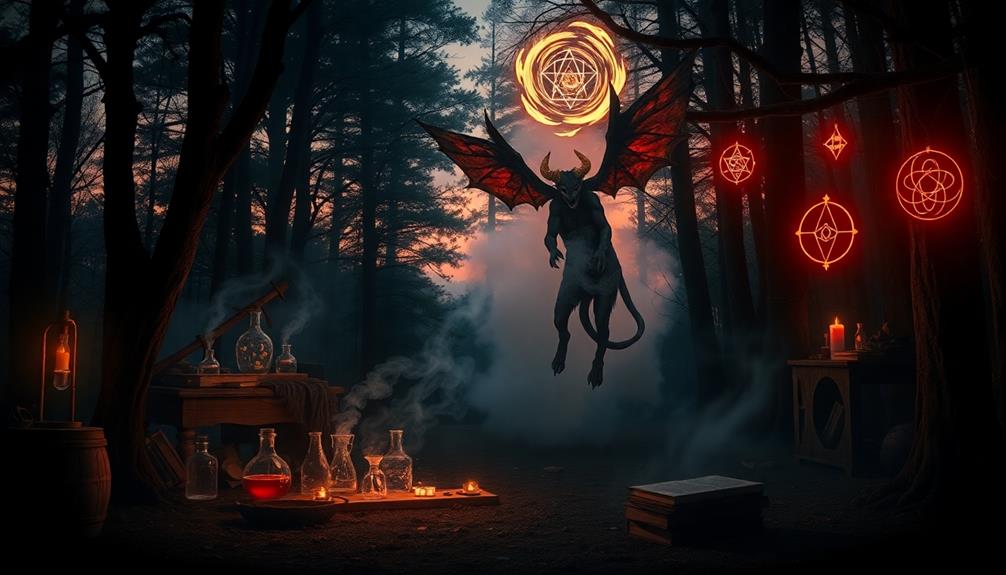
In early America, alchemy emerged as a fascinating blend of European scientific traditions and indigenous practices, capturing the imaginations of many. This pursuit focused on the transformation of materials and the elusive philosopher's stone, believed to grant immortality and wealth. Influential figures like Benjamin Franklin and Cotton Mather engaged in alchemical studies, showcasing the era's fascination with natural philosophy and the potential of alchemy to advance scientific understanding.
Alchemical practices often encouraged a form of minimalism for personal growth, as practitioners sought clarity in their intentions and desires, emphasizing the importance of meaningful experiences over mere material gains.
Alchemy in early America often intertwined with religious beliefs, as practitioners sought to comprehend the divine order of the universe through matter manipulation. These mystical elements permeated early American literature and folklore, shaping cultural narratives that could lead to legends like the Jersey Devil. The stories surrounding this creature echo the alchemical quest for transformation and the fusion of the known and the unknown.
As the 18th century progressed, alchemy declined in favor of modern chemistry, marking a significant shift in scientific thought. However, the legacy of alchemy persisted, leaving behind a rich tapestry of mystical and fantastical tales that continue to intrigue and entertain.
The Jersey Devil, born from this alchemical tradition, remains a symbol of the enduring impact of these early practices.
Myth vs. Reality

As you explore the origins of the Jersey Devil folklore, you'll notice how it intertwines with early American fears and societal tensions.
This myth not only reflects cultural anxieties but also embodies alchemical symbolism, representing transformation and the unknown.
Folklore Origins Explored
While exploring the origins of the Jersey Devil legend, you'll find a fascinating interplay between myth and reality that reveals much about early American society. The story of Mother Leeds, who supposedly birthed a deformed child, reflects the colonial anxieties and social dynamics of her time.
As you dig deeper, you'll notice how the legend evolved, shaped by various influences. Key aspects include:
- The blending of local Native American legends with European folklore.
- The demonization of the Leeds family amidst political tensions.
- A shift in perception of the Pine Barrens, from mystery to isolation.
- The legend's role in illustrating societal issues like religious intolerance.
- The suppression of outspoken individuals, particularly women in early America.
This narrative serves as a cultural artifact, offering insights into historical memory. The Jersey Devil embodies the fears and prejudices of an era, transforming personal stories into collective folklore.
As you analyze these elements, you'll appreciate how myths like the Jersey Devil not only entertain but also reflect the complexities of the human experience, shaping public perception and our understanding of history.
Alchemical Symbolism Analysis
Alchemy provides a rich framework for analyzing the symbolism inherent in the Jersey Devil legend. When you explore the tale, you see that the Jersey Devil embodies a failed transformation—representing the darker aspects of human nature rather than the noble goals of alchemy. The Leeds family's history, intertwined with the creature's origins, hints at chaos and the struggle for control over nature, much like the alchemical pursuit of turning base metals into gold.
The winged dragon in the Leeds family crest symbolizes the chaotic force that must undergo transformation, paralleling the Jersey Devil's monstrous qualities. You might also consider the Philosopher's Stone, a symbol of ultimate enlightenment, which starkly contrasts the legend's narrative of degeneration. This duality of creation and destruction is echoed in alchemical texts.
Moreover, the connection between Mother Leeds and her 13th child reflects societal anxieties about the "other." This mirrors the fears surrounding alchemical practices, where blending science and superstition led to the demonization of those who didn't fit societal norms.
In this light, the Jersey Devil serves as a cautionary tale about the misunderstood and the unknown in early American society.
Cultural Significance of Folklore
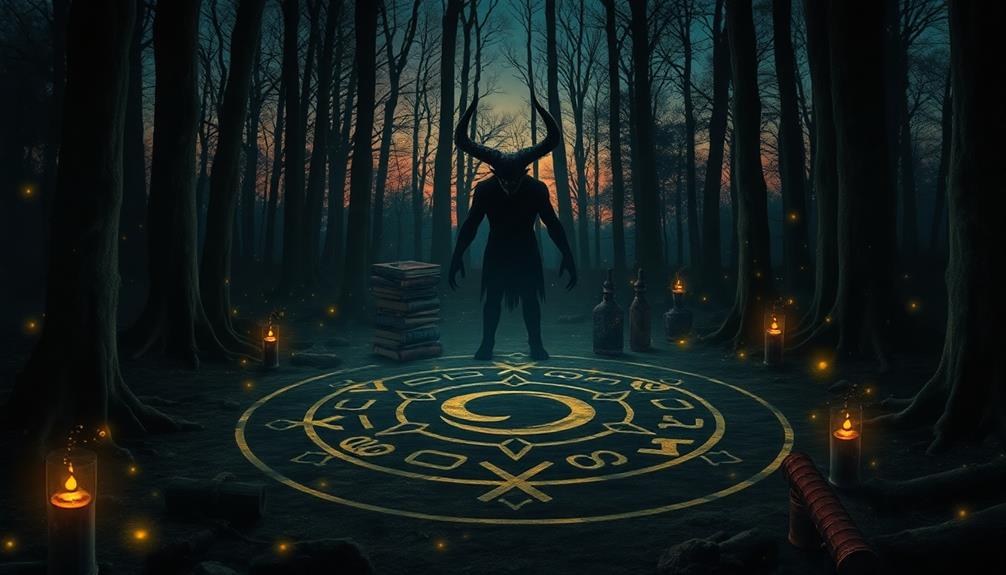
Folklore, like the Jersey Devil legend, shapes your understanding of identity by reflecting societal fears and values.
As you explore these stories, you'll see how they mirror the anxieties of their time, particularly concerning the unknown.
This connection highlights the role of myths in forming cultural narratives and fostering community ties.
Mythical Identity Formation
Exploring the Jersey Devil legend reveals how mythical identity formation plays a significant role in shaping cultural narratives. This legend, rooted in the Pine Barrens, encapsulates the complexities of early American life, reflecting communal fears and societal expectations.
The psychological impact of folklore, akin to the effects of narcissistic abuse recovery, illustrates how collective trauma can be woven into cultural narratives. You can see its cultural significance in several ways:
- The tale of Mother Leeds highlights anxieties surrounding childbirth in a patriarchal society.
- The transformation of the Leeds family narrative into the Jersey Devil myth serves to demonize individuals who defy social norms.
- Alchemical themes connect the legend to a fascination with transformation and the unknown.
- The story acts as a vehicle for expressing collective fears, reinforcing regional identity.
- The ongoing resonance of the Jersey Devil narrative engages communities in preserving their folklore.
These elements demonstrate that mythical identity formation isn't just about the creation of a monster; it's about understanding the underlying cultural currents.
The Jersey Devil legend evolves, illustrating how myths can encapsulate the anxieties, hopes, and communal identities of a society in flux. As you probe into this folklore, you uncover the intricate layers that contribute to its lasting impact.
Societal Reflection in Folklore
The Jersey Devil legend serves as a mirror reflecting the societal anxieties of its time, capturing the fears and complexities of early American life. Nestled in the isolation of the Pine Barrens, this folklore emerges from a period rife with superstition and uncertainty. Communities used tales like that of the Jersey Devil to process their collective fears, especially amid political tensions and social upheaval.
The narrative resonates with the experiences of those maneuvering gaslighting in custody battles, showcasing how individuals can become targets of manipulation and deceit in times of distress.
This legend highlights how society often scapegoated individuals, particularly women, echoing the demonization faced by figures like Mother Leeds and Anne Hutchinson. As you explore the narrative, you can see a clear societal reflection of early American cultural values, revealing the inherent need for a shared identity amidst chaos.
The evolution of the Jersey Devil's story showcases how folklore adapts, becoming a symbol of regional pride and identity for New Jersey. The intersection of myth and reality in this tale emphasizes storytelling's role in shaping historical memory and fostering community cohesion.
Political Influences on the Legend

Political rivalries played an essential role in shaping the legend of the Jersey Devil. The tensions between figures like Daniel Leeds and Benjamin Franklin created a backdrop where suspicion and supernatural fears flourished. The Leeds family's controversial views, alongside Daniel's expulsion from the Quaker faith, fueled the demonization that intertwined their legacy with the Jersey Devil.
You can see how political influences crafted this narrative through several factors:
- The rivalry intensified public suspicion, associating the Leeds family with witchcraft.
- The 1730s and 1740s saw the legend grow amid colonial politics and societal fears.
- The creature's monstrous depiction reflected societal anxieties about dissent and nonconformity.
- The Jersey Devil represented a unifying symbol during the American Revolution, as communities rallied against perceived threats.
- The narrative's evolution mirrored changing political sentiments, embedding it further into local folklore.
As you explore these connections, it's clear that the Jersey Devil didn't just emerge from the woods; it was deeply rooted in the political landscape of its time, embodying fears and conflicts that resonated with the people of early America.
Transformation of the Narrative

As you explore the transformation of the Jersey Devil narrative, you'll see how its mythical origins shift from a politically charged tale tied to the Leeds family to a broader monster legend.
This evolution reflects cultural anxieties and changing perceptions of the Pine Barrens and its people.
Mythical Origins Explored
Exploring the mythical origins of the Jersey Devil reveals a fascinating transformation that intertwines folklore with early American alchemical themes. This transformation reflects a period where myths borrowed from scientific inquiry shaped societal narratives.
You'll find that several key elements contributed to this evolution:
- The Leeds family's political demonization mirrors the alchemical pursuit of transmutation.
- Oral traditions in the 1830s and 1840s highlighted a growing interest in mystical alchemy.
- The Jersey Devil's association with witchcraft reflects societal anxieties about scientific advancements.
- Folklore served as a medium to negotiate cultural fears around change and uncertainty.
- Alchemical themes in these narratives emphasized the boundaries of life and creation.
As you investigate deeper into these elements, it becomes clear that the narrative of the Jersey Devil evolved in response to the complexities of early American society.
The interplay between folklore and alchemical thought not only crafted the creature's mythical identity but also revealed deeper societal tensions. In this light, the Jersey Devil embodies more than just a scary tale; it's a reflection of the struggles between tradition and the emerging scientific worldview of its time.
Cultural Reflections Revealed
The transformation of the Jersey Devil narrative reveals much about the cultural landscape of early America, showcasing how folklore can mirror societal shifts and anxieties. Initially viewed as a reflection of the Pine Barrens' wilderness, the story evolved under the influence of early American alchemy, shaping its fearsome reputation.
You see, the Leeds family's ties to alchemy and scientific inquiry intertwined their legacy with political struggles, further demonizing their image.
As the legend progressed, the Jersey Devil morphed from a malformed child into a monstrous entity, symbolizing the identity crises and fears surrounding the unknown in that era. Oral traditions encapsulated the alchemical motif of transmutation, illustrating how communities grappled with moral dilemmas amid change.
Moreover, the emergence of the Jersey Devil in the Colonial context served as a commentary on the clash between Enlightenment ideals and traditional beliefs. It's fascinating to think that while some debated whether Jersey Devils were real, others found in the myth a way to articulate their anxieties about transformation and the mysteries of nature.
This interplay between folklore and societal reflection continues to resonate, reminding us of our shared human experience.
The Role of Women in Folklore
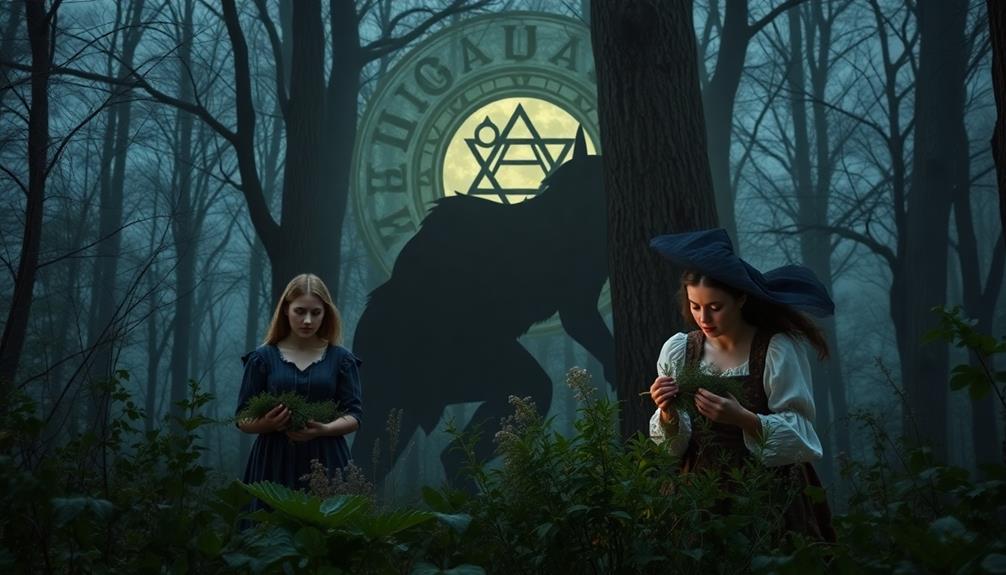
Women play an essential role in the tapestry of folklore, shaping narratives that reflect societal values and fears. In the case of the Jersey Devil, the legend of Mother Leeds illustrates how women's stories often intertwine with cultural anxieties. As you explore these narratives, consider how they reveal the complexities of female existence in early America.
- Women often challenge societal norms, like Anne Hutchinson, who faced severe repercussions for her beliefs.
- The Jersey Devil embodies fears surrounding women who step outside traditional roles.
- Folklore frequently includes cautionary tales about witches, showcasing anxieties about female power and independence.
- Oral traditions, passed down by women, serve as vessels for community values and cultural anxieties.
- Alchemical practices, historically linked to women, represent a pursuit of knowledge often demonized as witchcraft.
These elements highlight how women, through their roles as storytellers and figures like Mother Leeds, contribute to the rich tapestry of folklore.
Their narratives don't just entertain; they serve as reflections of the struggles and challenges faced by women in society, capturing a crucial part of cultural history.
Scientific Skepticism and Explanations
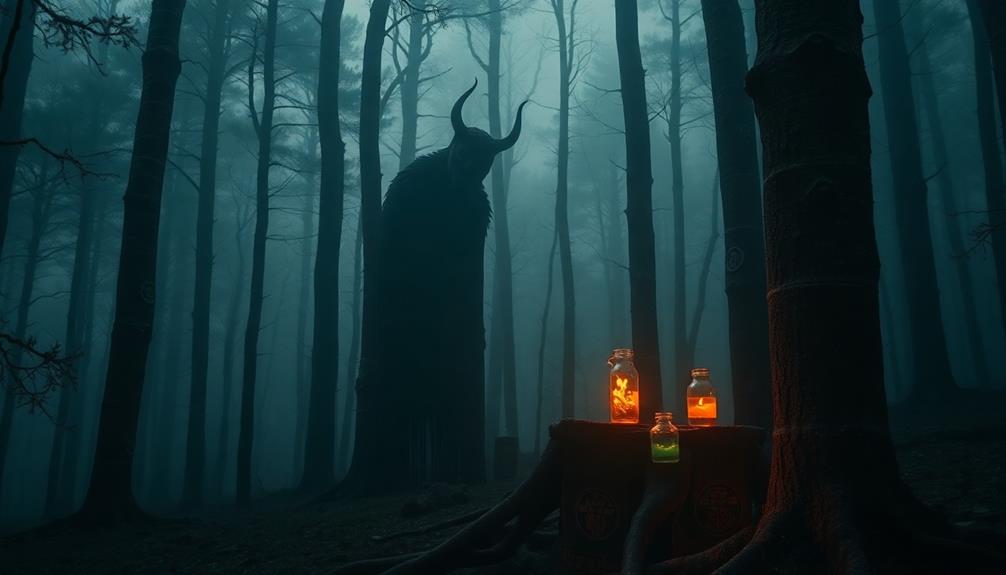
While many are captivated by the legend of the Jersey Devil, scientific skepticism reveals a stark contrast between folklore and reality. Researchers emphasize the lack of physical evidence supporting the creature's existence, suggesting that reported sightings are often misidentified animals or psychological phenomena.
For instance, many encounters coincide with local wildlife, like deer or large birds, indicating that environmental factors and folklore shape these misinterpretations. The concept of "collective hallucination" may further explain why entire communities report similar sightings. Shared beliefs and cultural narratives can distort individual perceptions, leading to a widespread acceptance of the myth.
Wildlife experts advocate for recognizing the rich biodiversity of the Pine Barrens, which can easily give rise to stories like the Jersey Devil when unusual animal behavior is misinterpreted. Scholars like Dr. Brian Regal highlight that the historical context of alchemy and pseudoscience in early America played a significant role in creating such myths.
The fascination with supernatural explanations for natural phenomena contributed to the lore surrounding the Jersey Devil, illustrating how scientific skepticism offers a more grounded understanding of this enduring legend.
Modern Interpretations and Media
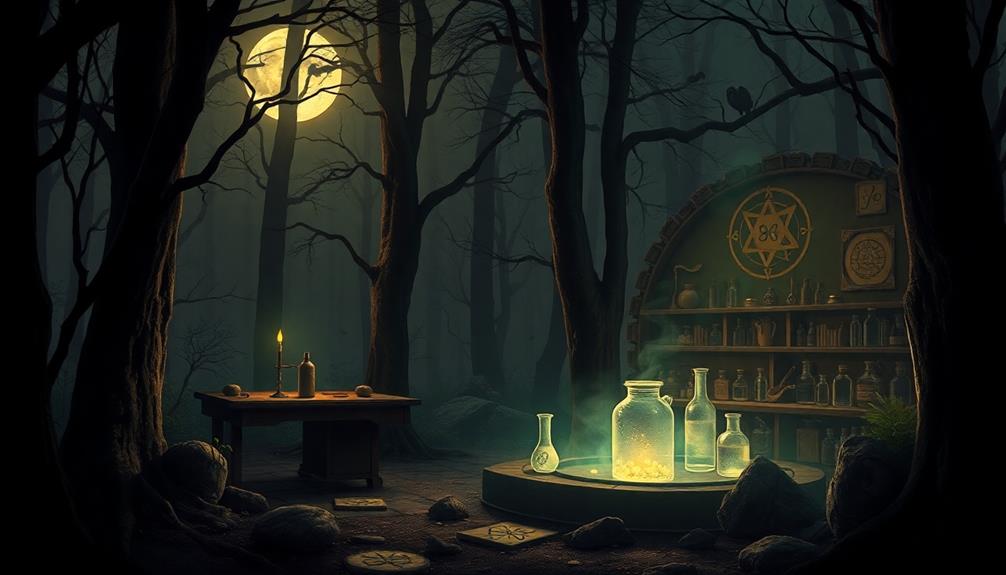
As scientific skepticism reshapes our understanding of legends like the Jersey Devil, modern interpretations breathe new life into the myth.
Today, you'll find the creature represented across various media, blending horror and folklore to enhance its mystique. This revival highlights the Jersey Devil's cultural significance in New Jersey and beyond.
- Films and television shows depict the Jersey Devil as a fascinating monster, keeping audiences intrigued.
- Graphic novels and visual art showcase the dual nature of the creature, blending beauty and terror.
- Social media platforms allow users to share personal sightings, blurring the lines between myth and reality.
- Documentaries and podcasts explore the legend's historical roots, merging folklore with scientific skepticism to engage listeners.
- Local festivals celebrate modern interpretations, reinforcing community ties and promoting regional tourism.
These modern interpretations not only keep the legend alive but also contribute to a rich tapestry of folklore that defines New Jersey's cultural identity.
Community Engagement and Preservation

The Jersey Devil legend serves as a powerful catalyst for community engagement and preservation, fostering local pride and identity among residents. You might find yourself drawn into various folklore preservation efforts, where storytelling and cultural events bring the legend to life.
Local festivals celebrating the Jersey Devil not only attract tourists to the Pine Barrens but also boost the economy, enhancing awareness of the region's unique folklore.
Educational programs organized by historical societies shed light on the Jersey Devil's significance, encouraging discussions about historical context and societal issues. These programs often explore the suppression of outspoken individuals, particularly women, drawing connections to figures like Mother Leeds.
By participating in these discussions, you can examine how myth intersects with reality.
Collaborative efforts among local historians, educators, and community members aim to shift the narrative from mere myth to a richer historical context. This focus emphasizes the importance of preserving local folklore, ensuring that the legend of the Jersey Devil continues to resonate with future generations.
Engaging in this preservation not only honors your community's heritage but also strengthens the bonds among residents who share in this unique cultural identity.
Conclusion
In exploring the origins of the Jersey Devil through the lens of early American alchemy, you've uncovered a rich tapestry of myth and reality. Did you know that over 70% of Americans believe in at least one urban legend? This statistic highlights how folklore shapes our understanding of the world. By engaging with these stories and their cultural significance, you not only preserve history but also ignite curiosity in future generations about the magic hidden in our past.










